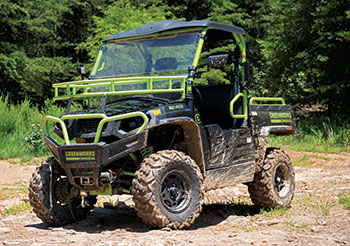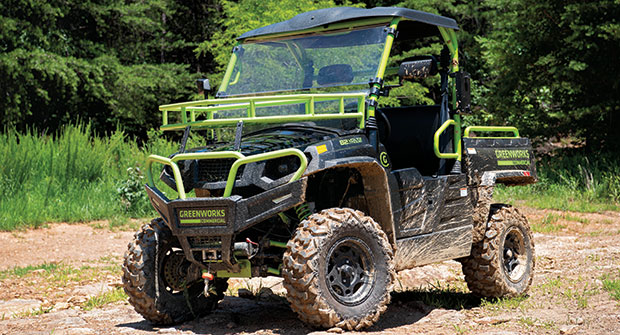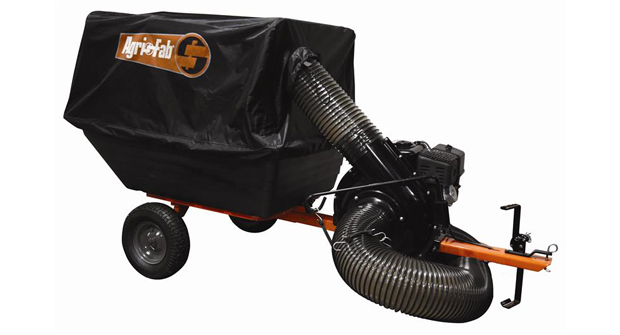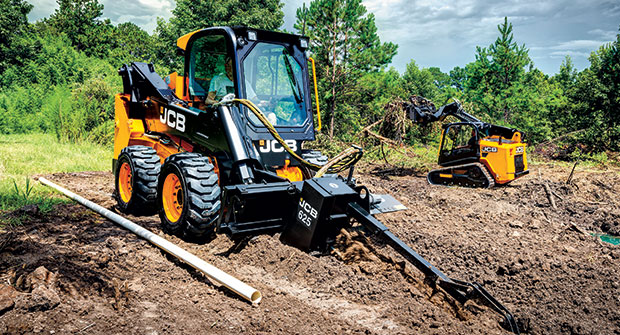
Including landscape maintenance and snow removal jobs, utility vehicles are rolling out on more job sites because of their versatility and ability to handle rough terrain, says Joel Hicks, senior product support manager at Kioti.
“The primary purpose is to get people and the tools they need to multiple locations that are not really accessible,” Hicks says. “The versatility (of UTVs) is beginning to be recognized more and more than it was five or 10 years ago.”
There is also the option to add accessories that make them even more productive year-round. That includes aftermarket attachments like spreaders, sprayers, brooms and plows.
Before buying or leasing, landscapers should look at a UTV’s features: what it can haul, how many people it can carry, steering options and possible accessories. These vehicles also allow landscapers to access more rugged and contoured areas than work trucks typically do, says Tony Marchese, vice president of sales and operations for Greenworks North America’s commercial business group.
“Utility vehicles have become a convenient, multitask tool that can transport, haul, dump or pull to assist landscapers complete tough, everyday jobs,” Marchese says.
Tackle terrain
Putting these vehicles to the test each day is the Gothic Landscape team, which operates in California, Nevada, Utah and Arizona. The $67 million company offers landscape construction and maintenance services for commercial properties.
Gothic uses UTVs on large HOA properties, golf courses and other big job sites, says Chris Williams, fleet manager for Gothic Landscape in Santa Clarita, Calif. The company’s crews transport equipment and employees on the vehicles across areas that are inaccessible or difficult to navigate with a truck.
“They save labor and also save employees from carrying stuff around, which helps safety, as well,” Williams says.
His company has more than 70 UTVs in its fleet, including ones from John Deere, Club Car and Kawasaki. Some of its clients require the firm to use electric UTVs along with electric maintenance equipment.
Gothic uses UTVs over other pieces of equipment because they cost about five times less than larger vehicles, are convenient and can handle tricky terrain, he says.
“On some types of properties, you can only have UTVs,” Williams says. “There are areas you can’t get to with a truck or clients that don’t want trucks there.”
He encourages other companies to do an assessment of the job before purchasing a UTV to decide what works best: two-wheel or four-wheel drive, accessories, electric or gas, contract requirements and other factors.
Gas and electric options
Whether they make their decision based off personal preference, cost or client requests, landscapers have several options when it comes to choosing a gas or electric UTV — or some of both.
“I think a lot of what dictates the type of vehicles they’re looking for is what their current product offer is,” Hicks says.
If they primarily use gas equipment, Hicks says, having a gas-powered UTV allows for a common format and fuel type.
“They can fill up the backhoe or mower with the same (fuel) as their UTV,” Hicks says.
For those using or considering electric equipment, Greenworks offers battery-powered UTVs, including the new CU500 and CU800 lithium-ion-powered UTVs.
These vehicles help save landscapers on maintenance time and costs because they don’t use gas or oil.
“Landscape pros love that they can begin some tough jobs earlier in the day, thanks to the low noise from our vehicles,” Marchese says.


